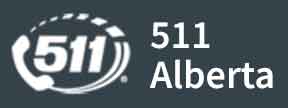Winter Operations FAQ | Mainroad North Island Contracting LP
During winter operations, Mainroad experiences a high frequency of questions from the public and media by phone, email, and social media. This document aims to answer most frequently asked questions and provide other helpful resources. Can’t find what you are looking for? Please contact Mainroad’s 24-hour public information hotline toll free at 1-877-215-7122.
What is the road/highway service area that Mainroad North Island Contracting is responsible for maintaining?
The North Vancouver Island Service Area 3 is approximately 3,474 lane kilometers of roadway. This service area contains four numbered routes: Highway 19 & Highway 19A connecting the North Island Service Area with the Mid-Island Service Area 2 and at Cook Creek, Highway 28 to Gold River, and Highway 30 to Port Alice.
North Island encompasses the Comox Valley, Campbell River, Port McNeill and Port Hardy, along with the smaller municipalities of Port Alice, Alert Bay, Sayward, Gold River, Tahsis, and Zeballos. We also service the following:
- Denman Island
- Hornby Island
- Quadra Island
- Cortes Island
The service area includes the maintenance of approximately 11 Rest Areas, and 312 Structures, including 194 bridges, 74 major culverts, 33 retaining walls and four tunnels.
*Please Note: Mainroad is not responsible for plowing within municipal boundaries or on forestry service roads and any snowplow discharge falling on residential driveways is the responsibility of the property owner.
TranBC Link: 4 Reasons Why Piling Your “Private Snow” on Roads is a “No”
Mainroad’s contract with the Province does not include road/line marking. Pavement marking is a separate maintenance contract with the Province held by LaFrentz Road Marking. Please contact LaFrentz Road Marking 1-800-859-2947 | www.lafrentz.ca
Mainroad is not responsible for ice and snow maintenance around mailboxes.
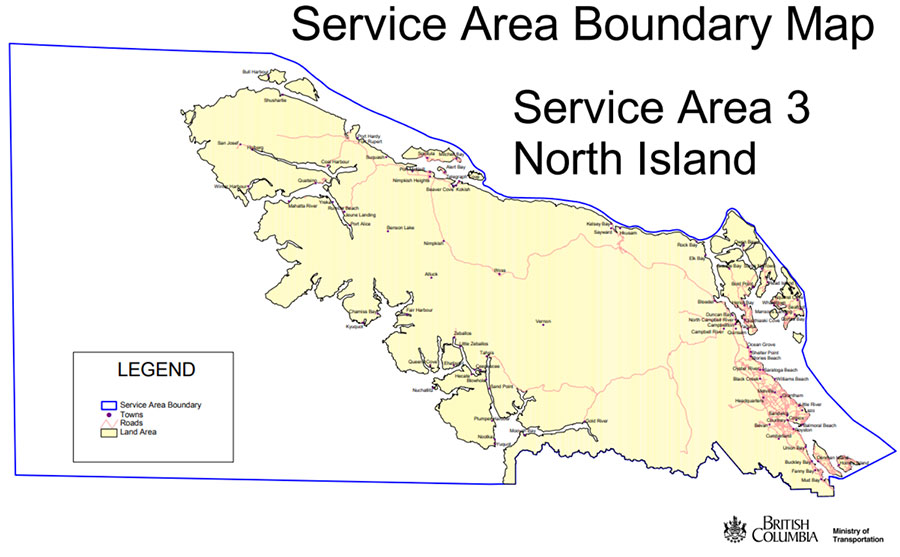
Where are Mainroad's maintenance yards located?
The headquarters and primary works yard for Mainroad North Island Contracting is in Cumberland with supporting works yards in:
- Campbell River
- Gold River
- Port McNeill
- Sayward
- BC’s Gulf Islands | Quadra, Cortes, Denman and Hornby
How many Mainroad employees are working during winter operations?
Our fleet and crews are fully engaged in winter maintenance operations. Up to 80 employees plus mechanical support are available to work around the clock to keep our roads clear.
How does Mainroad monitor weather and highways conditions?
As the weather can change rapidly on Vancouver Island, Mainroad is continuously monitoring weather and highway conditions Mainroad is constantly monitoring weather and highway conditions. To determine how best to protect motorists, we oversee weather in two ways:
1. Monitoring: Mainroad uses MARWIS, is a mobile road weather information sensor that measures road conditions and environmental data both reliably and professionally. The sensor is directly installed on the vehicle to collect weather data such as temperatures, humidity, and dew points. This helps our crews manage the road surfaces.
Road Patrols: Prior to and during a storm event, our operators are on the road observing current conditions and making the calls as to what maintenance is required.
2. Forecasting: Mainroad uses data derived from Road Weather Information System (RWIS) stations throughout our maintenance areas for weather forecasting.
Road Weather Forecasting: Environment Canada’s Meteorological Service of Canada does not perform road weather forecasting. This vital service is only available through private sector service providers. Mainroad contracts with a leading road weather forecaster, which watches over B.C. weather 24 hours a day, seven days a week.
TranBC Link | More on how the BC Ministry of Transportation & Infrastructure monitors weather and highway conditions
Environment Canada also contributes to our weather watch, providing regional forecasts. Combined with additional weather information from other sources, these tools help us predict road conditions. But firsthand experience is also a big part of knowing our roads. That is why Mainroad patrols the highways on a regular basis.
What is Mainroad doing to prepare for a winter storm event?
Mainroad crews will be patrolling service area highways and roads while monitoring the forecast closely. Crews will apply specific material to the road surface as determined by the forecast and actual weather conditions. Pre-storm activities typically include anti-ice brining and monitoring the forecast closely. The proactive use of an anti-icing brine (for example) is a proven way of combatting ice from forming on the highway surface. This technique is used throughout most highway maintenance jurisdictions in North America. During a heavy rain advisory, crews will check, and clear service area catch basins.
Ahead of a weather event, Mainroad releases regular road and weather updates to a contact list of local agencies, various stakeholders including the Ministry and Media to help inform the public. This helps everyone understand the current conditions, expected weather and Mainroad’s response. These updates are also posted on our social media.
When a weather event occurs, (snow, freezing rain, flooding, etc.) our fleet and crews will be engaged in winter maintenance operations. Up to 80 employees plus mechanical support are available to work around the clock plowing, sanding and/or salting as conditions warrant and patrolling the service area. Additional crews will be called into to plow the roads.
What materials does Mainroad use for winter road maintenance and when are these materials applied?
Mainroad primarily uses two materials on Vancouver Island for winter road maintenance: anti-icing brine and de-icing salt with winter sand as required. The use of a specific material is determined by the forecast, actual weather conditions and in accordance with the standard set by the Ministry.
Anti-icing Liquids (brine): Anti-icing liquids are used as a preventative material prior to snowfall. Typically, these materials are applied prior to a forecasted winter event and dry on the highway surface to provide early on snow melting capabilities. Brine can also act as a de-icing agent during a storm or once a storm has passed and can help to remove packed snow and ice from the road surface. After snow has been cleared, liquid anti-icing brine is an important component in Mainroad’s plan to prevent ice from forming as it breaks down the bonding ability of ice on the road surface.
Learn more about Mainroad’s liquid anti-icing program
Salt: Salt is a staple of our winter maintenance routine. Sometimes salt is used in a liquid (salt brine), sometimes in a solid. Salt melts the ice and dissolves the snow into slush or water but if the snow keeps coming, it will dilute the salt and make it less effective. Salt is only effective in certain temperatures. If temperatures fall below -5C, salt becomes less effective.
Winter Sand: The winter sand used by Mainroad is a graded material specified by the Ministry of Transportation and Infrastructure. Winter abrasives improve traction. During a snow event, restoring traction will be completed by either applying winter abrasives on compact sections or by applying winter chemicals to compact sections to melt snow and ice when pavement temperatures are above -9C.
The use of a specific material is determined by forecast and actual weather conditions.
Why are some roads plowed more than others? Which streets get plowing priority?
Mainroad’s response time is determined by the standards set by the Ministry of Transportation and Infrastructure. Priority is given to major highway routes such as numbered highways and school bus routes because those are the ones used by emergency services and the majority of traffic. Other road frequency is determined by winter traffic volumes. These frequencies are reviewed annually by the Ministry to ensure that plowing priorities reflect any changes in the road network.
TranBC Link: How BC highway maintenance contracts have changed for the better
TranBC Link: The ABC’s of winter highway classification and maintenance in BC
TranBC Link: A look behind the scenes at winter maintenance in B.C.
What is Mainroad doing to respond to changing conditions during a storm event?
Weather can change rapidly on Vancouver Island which is why Mainroad is constantly monitoring weather and highway conditions.
During a storm event, Mainroad crews will be working to clear the highway surfaces as quickly as possible. When temperatures permit, we will commence anti-icing operations with the goal of getting the compact snow off service area highways and roads. On primary routes, we will aim to have bare and black conditions from the completion of the weather event as quickly as possible however challenging weather will not always permit us to have bare and black conditions on secondary routes.
Mainroad crews will also be patrolling Service Area highways for down trees and vegetation on the road however it will take some time to clear a down power line so check DriveBC for updates. Mainroad will coordinate with BC Hydro to determine when the area is safe.
Never try to approach or drive across a down power line. Remain at least three metres (10 feet away) from power lines. That means above, below, and beside. Call 911 to immediately report a fallen power line. Avoid touching anything, such as a car, object or equipment, or anyone who is in contact with a fallen power line. Keep children and pets away from fallen electric lines.
During every storm event, Mainroad will provide the Ministry and Media with regular updates.
Driveway Culvert Maintenance Responsibilities on BC Highways: Your Questions Answered
- Feel free to contact Mainroad’s 24-hour hotline to report a driveway culvert or culvert maintenance issue.
- Alternatively you can contact your local Ministry Regional and District Office Staff. Information available at this link: Transportation Reports and Reference – Regional District Contacts
TranBC Link | A look behind the scenes at winter maintenance in B.C.

Who ensures the work is being done properly?
There are two ways in which work is assessed against contractual commitments:
Mainroad has a vigorous quality assurance program in place, which tracks our own performance. Should areas of concern be detected, measures are put in place to deal with the shortcoming and processes are modified to prevent recurrence. Mainroad is an ISO compliant company and its quality programs are built on those models.
The Ministry of Transportation and Infrastructure has an ongoing inspection process that involves a high-level overview using resources from areas across the Province, as well as numerous detailed inspections that drill into the inside workings of Mainroad’s maintenance practices. Mainroad has a very good performance rating, as measured against our contractual commitments.
Where can I direct concerns about road conditions to Mainroad North Island Contracting?
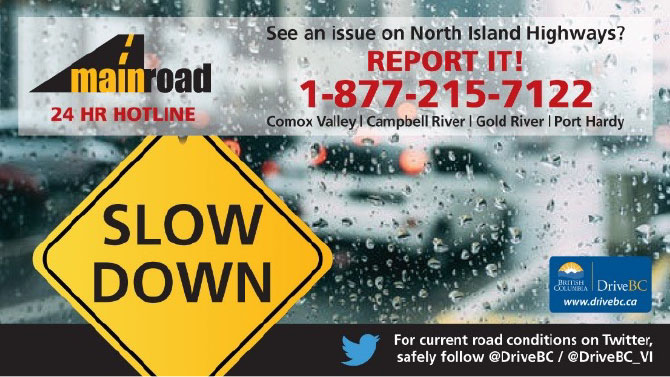
Mainroad’s Call Centre is available 24 hours a day, 7 days a week – the operator will record all public feedback and forward the information to our crews on shift to respond, as well as dispatch additional personnel, and update DriveBC
You can also write Mainroad: Email – northisland@mainroad.ca
![]() Follow us on X (formerly Twitter) Mainroad North Island Contracting currently maintains an X account: @mainroadnisland
Follow us on X (formerly Twitter) Mainroad North Island Contracting currently maintains an X account: @mainroadnisland
![]() Follow us on Facebook! Mainroad North Island Contracting maintains a Facebook business and group page: Mainroad North Island Contracting LP
Follow us on Facebook! Mainroad North Island Contracting maintains a Facebook business and group page: Mainroad North Island Contracting LP
Where can I find news about Mainroad?
Please visit our recent news page
Heading to Mount Washington Alpine Resort?
Here is what you can do to stay safe during winter driving conditions
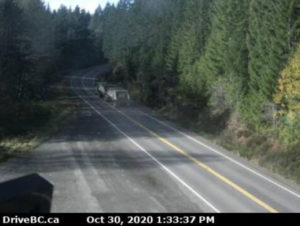 Visit DriveBC | www.drivebc.ca
Visit DriveBC | www.drivebc.ca
- For current road conditions
- For weather forecasts
- For real-time conditions via webcams
Fall and winter weather can be unpredictable and when we tend to experience all types of driving conditions on Vancouver Island, heavy rain, fog, icy conditions, and snow.
Give your vehicle a winter check-up and equip your family with a winter survival kit so you are not caught off guard when weather conditions deteriorate.
We encourage drivers to choose the best winter tires possible when driving in snow and ice, and to ensure tires are in good condition, with a minimum tread depth of 3.5 mm.
Carry an emergency survival kit with non-perishable food, blankets and first aid supplies, windshield scraper and snow brush, extra windshield washer fluid, fuel line antifreeze, flares and matches or lighter, tire chains and gloves, shovel and traction mat, sand or kitty litter, flashlight and extra batteries, battery jumper cables, spare tire wheel wrench and jack, extra clothing and footwear and sandbags for extra weight.
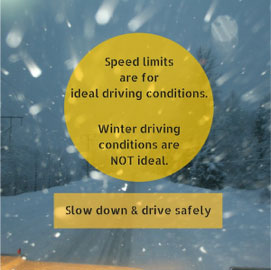 Driving during winter driving conditions
Driving during winter driving conditions
- Conditions change and so should your speed. Please SLOW DOWN and drive for the conditions.
- We encourage all motorists to drive to the conditions during the winter season, slow down, and increase the distance between yourself and the vehicle in front of you.
TranBC Link: How to drive around snow plows in British Columbia
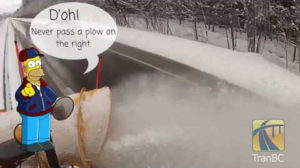 Snow Plow Safety Do’s and Don’ts
Snow Plow Safety Do’s and Don’ts
Do……Turn on your head and taillights during heavy snow or rain, even during the day.
Do……Use winter-rated snow tires with the mountain-snowflake symbol.
Do……Watch for the flashing amber lights. It can be difficult to see snow removal equipment.
Do……Give snow plows plenty of space – about 10 car lengths. Salt and winter abrasives, as well as rocks and other debris in the snow, can fly – hitting nearby vehicles and decreasing visibility.
Do……Remember the road surface ahead of the plow hasn’t been plowed yet therefore please slow down and be patient. The operator will eventually pull over when it is safe to do so to allow motorists to pass, so take your time, wait and be safe.
Do……Pull as far over to the right as is safe when you see a snow plow approaching from the opposite direction along an undivided highway. That way, you will be clear of any salt or winter abrasives.
Do……Give the snow plow operator a wave when they pull over to let you pass. They’re doing the job for you!
Snow Plow Safety Do’s and Don’ts
Don’t……Assume the snow plow operator can see you, especially if you’re driving too close and visibility is poor (which it often is in snowstorms). Your best defense is to keep your distance.
Don’t…
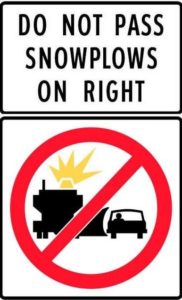
…Pass snow plows. It’s not safe. When drivers attempt to pass a plow truck, they put themselves, their passengers, the snow plow operator and other motorists at risk. The plow could be equipped with a wing blade on its left or right side, which can be obstructed by the snow it’s throwing. The plow also may be the first of a series of two to four more plows, staggered diagonally across the road to clear all lanes simultaneously. This practice is called Echelon Plowing and would require the unwise driver to make multiple unsafe passes.
Don’t……Tailgate. Tailgating any vehicle puts you at risk of a collision; tailgating a piece of heavy equipment armed with plows only ups the consequences.
Drivers may not be aware…Snow plows must travel slower than regular traffic when pushing snow and spreading salt and winter abrasives.
Snow plows stop at railway crossings to ensure it is safe to cross and that the plow blade will clear the track.
Shift into Winter and TranBC Winter Driving Online Resources
Mainroad is a Winter Driving Safety Alliance partner. We actively promote Shift into Winter, a public awareness campaign designed to inform B.C. drivers about the importance of safe winter driving. We encourage everyone to visit www.shiftintowinter.ca for resources and tips on how to stay safe on the road this winter.

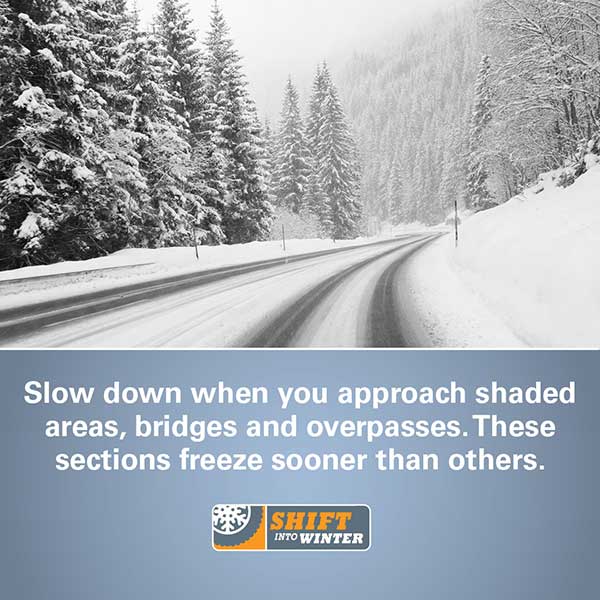
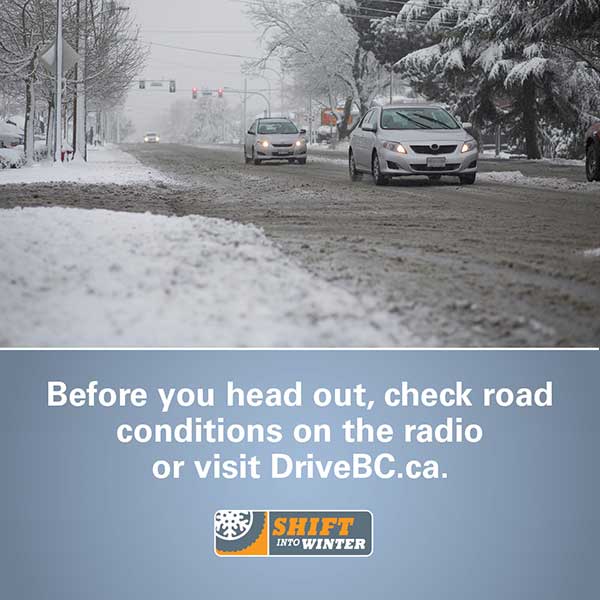
Additional information about B.C. Highway and Bridge Maintenance
Commercial Vehicle – Tire and Chain Requirements
Designated Winter Tire & Chain-up Routes
Enforcement of Winter Tires & Chains Requirement
Excessive Speed and Careless Driving
Motorcycle – Tire and Chain Requirements
Passenger Vehicle – Tire and Chain Requirements
Recreational Vehicle & Trailer – Tire and Chain Requirements
Travelling in an Avalanche Area
Municipal Snow Removal Operations
Comox Valley Regional District | road maintenance, snow removal, ditching
- northisland@mainroad.ca
- GM: Chris Cowley
- 3190 Royston Rd. Cumberland, BC V0R 1S0

